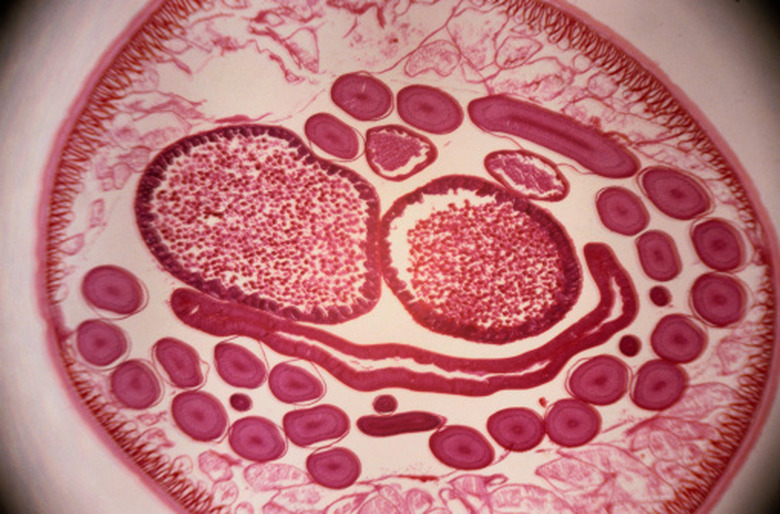Difference Between Nematodes & Trematodes
Both nematodes and trematodes are parasitic worms that prey upon various plant and animal hosts. Nematodes, also known as round worms, can be free-living, but many species live on animal hosts and produce serious disorders. Nematodes that infect plants can cause severe crop losses. Trematodes, known as flukes, infect animals, and their life cycles generally include residence in two different species: a primary and an intermediate host.
Body Form and Reproduction
Body Form and Reproduction
Nematodes have a simple body form, often referred to as a "tube within a tube," with a simple digestive system that extends from the mouth at one end to the anus at the other. Trematodes have flat, unsegmented bodies usually shaped like a leaf or an oval. Nematodes have two sexes and reproduce sexually. Except for members of the Schistosoma genus, trematodes are hermaphroditic, meaning they possess reproductive organs of both sexes.
Attachment Mechanisms
Attachment Mechanisms
Nematodes attach to their hosts via liplike or toothlike plates that surround their mouth openings. Food is sucked into the body cavity by the working of muscles that surround the opening. In some species that prey on plants, the mouth cavity has been modified into a hollow spear that can penetrate the plant tissue and withdraw food. Trematodes attach to their hosts with two suckers, one anterior and one posterior.
Human Diseases
Human Diseases
Nematodes can cause a number of serious diseases in humans including ascariasis, hookworm diseases, whipworm disease, trichinosis, pinworm infection and strongyloidiasis. These infections primarily affect the intestines of hosts and are most common in impoverished areas where sanitation standards are low. Trematodes can infect the skin, intestines, liver, blood, brain, lungs and other tissues of hosts, and symptoms can be severe and potentially life-threatening.
Plant Infections
Plant Infections
Unlike trematodes, nematodes are major agricultural pests. Several species attack corn, soybeans, potatoes and sugarbeets, often causing significant crop losses. Several species feed on turf gasses, and some fruit and ornamental trees are vulnerable as well. Although chemical controls are rarely effective, nematodes can be controlled by rotating crops and depriving the pest of their preferred host plants or by planting varieties that are resistant to nematode infection. Biological controls — the introduction of fungal, bacterial or insect predators — can also be utilized.
Cite This Article
MLA
Gillespie, Evan. "Difference Between Nematodes & Trematodes" sciencing.com, https://www.sciencing.com/difference-between-nematodes-trematodes-13406167/. 21 July 2017.
APA
Gillespie, Evan. (2017, July 21). Difference Between Nematodes & Trematodes. sciencing.com. Retrieved from https://www.sciencing.com/difference-between-nematodes-trematodes-13406167/
Chicago
Gillespie, Evan. Difference Between Nematodes & Trematodes last modified March 24, 2022. https://www.sciencing.com/difference-between-nematodes-trematodes-13406167/
